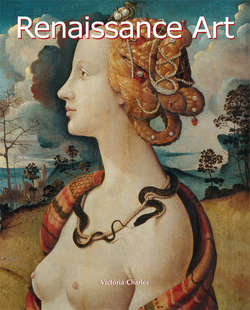Читать книгу Renaissance Art - Victoria Charles - Страница 5
I. Art in Italy
Leonardo da Vinci
ОглавлениеLeonardo da Vinci, The Virgin of the Rocks, 1483–1486.
Oil on panel, 199 × 122 cm.
Musée du Louvre, Paris.
Leonardo da Vinci and Andrea del Verrocchio, The Baptism of Christ, 1470–1476.
Oil and tempera on wood panel, 177 × 151 cm.
Galleria degli Uffizi, Florence.
Leonardo started his apprenticeship with Andrea del Verrocchio in approximately 1469, and was accepted into the master guild in Florence in 1472. How soon he was his master’s equal can be recognised in the Baptism of Christ (around 1475), with the angels and parts of the landscape he painted into the picture. Even at that time, his view of nature differed, due to the size of the structure of the form and his characteristic of the performances, which were seen as the peak of Florentine art. But the large picture handed over to him after he had completed his apprenticeship, an Adoration of the Magi, intended for a monastery church, was not finished. He really wanted to surpass all reputable Florentine artists with this painting; his plan never went further than the first undercoat of paint, despite many thorough preliminary studies. Even if his tendency as a painter and sculptor dominated, he also worked as an art theoretician and left behind many significant objects as an inventor and naturalist, as an architect, master builder of fortresses and a designer of engines of war. In the end, Leonardo’s creative power was no match for this universality, so later in his life, the completion of his pieces of work that had been prepared with a great deal of time, was occasionally at risk. Florence quickly became too constrictive for him, so that very soon he took an appointment to Milan to the court of Ludovico Sforza (1452 to 1508). His absolute masterpiece, The Last Supper (1495/1497) had to be restored for the first time as early as the sixteenth century, as it was subject to extensive decay, partly due to his appetite for experimenting, partly to climatic influence and wilful destruction. The gestures of his apostles, scenically arranged and summarised in a billowing movement, stand for his demand to depict “the intention of the soul” through movement.
The end of Ludovico Sforza’s reign was a catastrophe for Leonardo. He managed to save himself in time, and spent the years from 1499 to 1506 alternating between Florence and Venice and some other towns of the Romagna. He worked three years on his other absolute masterpiece, the picture of the genteel Florentine lady (Madonna) Mona Lisa (1503/1505), the wife of Francesco del Giocondo, and when they finally took it away from him, he explained that he had not finished it yet. Here, the atmosphere nestles around all forms, taking away any hardness and dissolving the sharp sculpture into a gentle blending together of all contrasts of colours and forms. This is where the great revolution, which broke new ground for painting, took place.
Leonardo da Vinci, The Annunciation, 1472–1475.
Oil on wood panel, 98 × 217 cm.
Galleria degli Uffizi, Florence.
Leonardo da Vinci, Drapery Study for a Sitting Figure, c. 1470.
Pen, grey tempera and white highlights, 26.6 × 23.3 cm.
Musée du Louvre, Paris.
In 1506, Leonardo travelled to Milan again and, apart from short interruptions, stayed there for ten years. During this time, Leonardo dedicated himself to his students and, increasingly, to his scientific studies and research. It is hard to comprehend the number of subjects in the various technical fields across which Leonardo occupied himself. Among the drawings he left – the Codex Atlanticus alone contains 1,119 – there are ideas for a rope producing machine or float to walk on water, a suggestion for a bridge that could be put up quickly, for a canon on a gun-carriage, for a parachute, for a (wind up) automobile, which, as experts found out, really works, and many more other indescribable things. The approximately 1000 sheets of the three-part Codex Forster contain drawings for hydraulic machines, theories on proportions and mechanics, notes on architecture and urban studies. A third Codex, the Codex Arundel, comprises in more than 280 sheets of drawings, of tanks and projectiles. Then there is a book on the human body, one on flights of birds, and, in the Codex Madrid with its 140 sheets, Leonardo deals with subjects such as painting, architecture, maps of Tuscany, as well as problems in geometry and mathematics and other things. And, regarding his 780 drawings on anatomy, it is quite appropriate that a British heart surgeon adopted these notes in 2005 and changed his operating technique accordingly. This listing is by no means complete and can only convey an approximate idea of Leonardo’s incredible spectrum of interests and skills.
During his years in Milan, the only painting that was finished was a youthful John the Baptist. In his studies of male and female heads he paid tribute, at least with the female heads, to the smile and often also beauty, and captured the range of expressions from grace and beguiling charm to proud dignity and arrogance. For the male heads, however, he captured more of the individual characteristics, which he then even sometimes exaggerated as caricatures. Such caricatures, with hideous, distorted features, found unusual approval and even turned up as copper engravings. Perhaps Leonardo had grown tired of his homeland despite all of his success, perhaps he simply wanted to avoid further confrontation with the younger Michelangelo – whatever the reason, he accepted the invitation and at the beginning of 1516 followed the king, who provided him with a flat in the Palace of Cloux near Amboise. There, no longer creative, but only giving advice in artistic matters, he spent the last years of his life and died on 2 May 1519.
Leonardo da Vinci, The Virgin and Child with St Anne, c. 1510.
Oil on wood, 168 × 130 cm.
Musée du Louvre, Paris.
